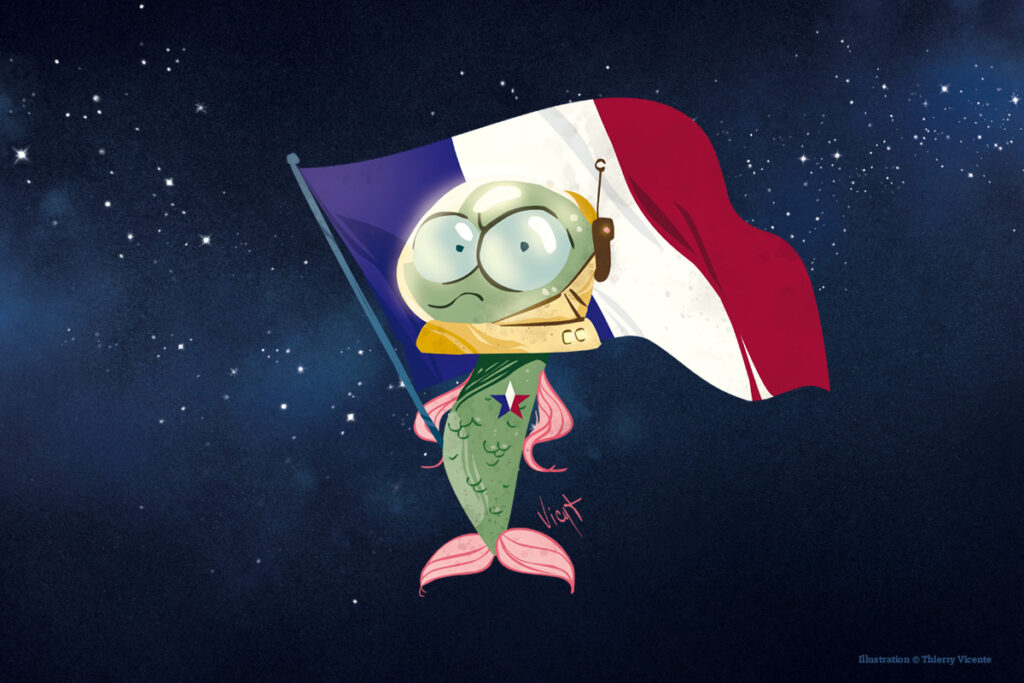[LUM#18] From the sea to the moon
Enjoying a codfish aioli overlooking Lac de la Félicité... a scene worthy of a science-fiction novel that could, one day, become reality thanks to the work of Cyrille Przybyla. His mission: to develop an autonomous closed-circuit aquaculture system to increase food security on Earth, even if it means landing on the Moon.

In 2015, astronauts on the International Space Station tasted the first lettuce grown in space(Sciences et avenir 6/03/2020). Since then, radishes, wheat and even peppers have taken root at an altitude of over 400 kilometers. This is a luxury when most of the food available on board is irradiated, freeze-dried or canned, but it's not enough to fill you up either, especially in view of future missions to the Moon.
So how do we ensure that these astronauts get their fill of animal proteins, vitamins and omega-3s? Fish! Except that, barring a miraculous catch, there's little chance of spotting a tail in the Sea of Serenity. Cyrille Przybyla, marine biologist at the Ifremer L-3AS laboratory, member of the Marbec* laboratory and specialist in integrated multi-trophic aquaculture (IMTA), has taken his hands out of the water and reached for the sky to solve this lunar problem. "I work on land. My aim is to successfully raise fish in a closed circuit by integrating several organisms, hence the term multi-trophic. It's a bit like a permaculture vegetable garden.
Everything changes
In this closed, controlled circuit, "nothing is lost, nothing is created, everything is transformed" might have declared Lavoisier a second time. The key word here is circularity," explains the biologist, " everything that is emitted by the fish in solid and liquid form must be able to be recovered and valorized by having it converted by other organisms." In this way, worms or sea cucumbers will be used to break down fish faeces, while at the same time providing a potential food source for the fish.
The CO₂ released by fish, like the ammonia given off by their digestive systems, will be able to serve as a basis for the cultivation of micro-algae. "These micro-algae, in addition to purifying pond water, will be able to enter into the composition of meals and thus avoid fishing wild fish to feed farmed fish. We're the first to do this," continues Cyrille Przybyla. In short, it's a win-win situation: water savings, reuse of molecules with high biological value, preservation of biodiversity and, last but not least, increased global food security.
Earthly food
"The FAO (Food and Agriculture Organization) is very interested in this biologically autonomous system, which can therefore be an excellent nutritional source in geographically isolated areas or in poor and extreme environments." And what could be more extreme than the Moon? Vibrations, hypergravity, microgravity, radiation... It's a whole range of tests that the researcher, who also holds a DU in celestial mechanics and is a graduate of the International Space University, had to put in place to test, as part of the Lunar Hatch project, the resistance of fish in space. Or rather, fish eggs, "because what's expensive in space is weight, and we can fit 200 eggs into a small 10/10 cm cube, whereas it would take over 1 m3 to send 200 adult fish".
The little cube in question is a CubeSat developed in collaboration with the Montpellier University Space Center(CSUM), with which the biologist is collaborating to carry out these take-off simulation tests. " We exposed sea bass eggs to the same vibration as Soyuz for ten minutes, then brought them back to Palavas to study the embryogenesis process. A total of 162 eggs hatched, giving the same results as our test group, so this first stage has been validated," explains Cyrille Przybyla.
Objective Moon
To test resistance to hypergravity, i.e. acceleration from 1G to 5G, the European Space Agency financed the rental of a centrifuge and a microgravity simulator. " We used the acceleration curve from the Soyuz lift-off and found no impact on the egg hatching rate. While radiation tests carried out in collaboration with the Institut de Radioprotection et de Sûreté Nucléaire (IRSN) are still underway at the Cadarache Atomic Energy Commission, the initial results are also encouraging, but further questions arise with each new step. "We manage to hatch these eggs, but are our fish born stressed? Does the radiation damage their DNA? In short, are the little larvae we're bringing into the world viable in a lunar environment?" asks the biologist.
These are just some of the questions he'll have to answer before 2032, the date scheduled for the European Space Agency's next biomission, which will take nearly 2 tonnes of biological experiments to the Moon, including, perhaps, our 200 little "fishonauts". In the meantime, Cyrille Przybyla flew to Florida for two months at the invitation of NASA. It's a great achievement for the man who admits he's "always had this idea in mind. I combined my passion for space exploration with the conviction and know-how gained from 20 years of research into fish production systems in controlled environments. It's by confronting the extreme constraints of space that we'll be able to meet the challenges of terrestrial life.
UM podcasts are now available on your favorite platforms (Spotify, Deezer, Apple podcasts, Amazon Music...).